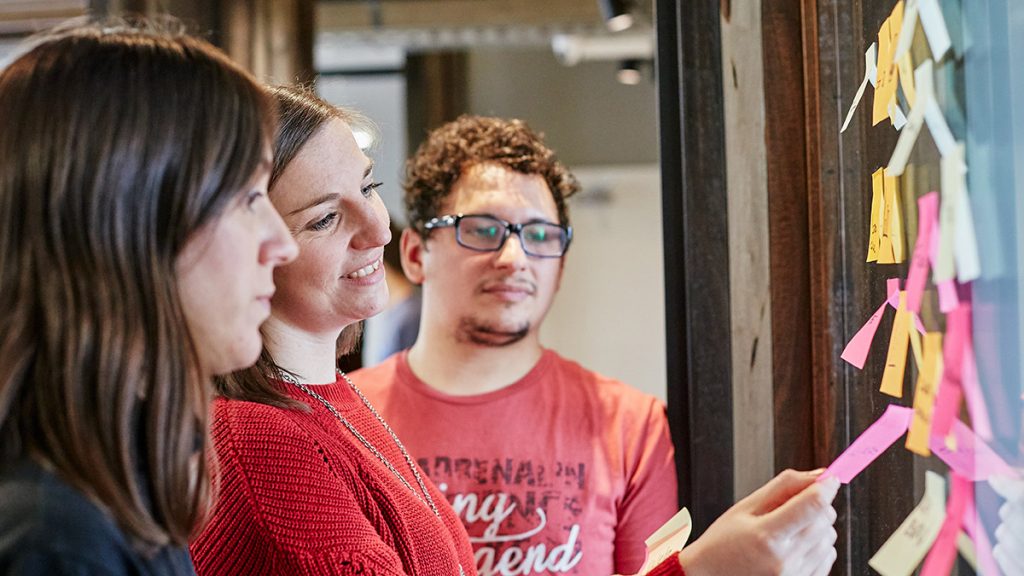Design Thinking is often described as a problem-solving method, originally used by designers to understand and thus elevate the customer experience. Indeed, we’ve covered this topic in our blog more than a few times, to describe our product development process.
As we come into contact with more companies through our work, we can see that interest Design Thinking has grown, spreading beyond the boundaries of the design world. Organizations from all industries are now interested in using Design Thinking as a process for engaging their own customers, with the goal of eventually winning not only their business but their loyalty as well.
But while they say they’re interested in using Design Thinking as a tool for solving problems, the questions they ask us bely a deeper interest in this approach. They seem to be wondering how to leverage these principles enterprise-wide, working them into the very core values of their organization.
And of course they’re onto something: in order to incorporate the customer-first values that underscore Design Thinking, companies have to be open to a whole new way of thinking: Design Thinking.
From the Customer Experience to the Employee Experience
Across the industry, software development companies like Making Sense are hearing questions from clients that range from the tactical: “Which users should we interview?” to the cultural: “How can we help other departments in our organization learn about and benefit from the values of design thinking?”
In other words, companies are asking how to get their people to accept the vision and put the values of Design Thinking into practice every day and in countless ways.
For answers, it can help to look at software development companies like Making Sense, who often have an edge up on incorporating the values of Design Thinking into the foundation of their enterprise. The reason: it’s simply because it’s in their industry where Design Thinking was widely spread.
Design Thinking as Company Culture
From our experience, Design Thinking is much more than a tool. It’s a culture — the values of empathy for the customer, the user, and the stakeholders are not only what drives us to create better products. These values help us to perform as an organization, as well.
In other words, Design Thinking isn’t just something you do — it’s something you are. So do you change your culture in order to act on its principles or do you start practicing Design Thinking behavior in order to change the culture? It’s a question that leaders are struggling with in every industry.
What Can Companies Do?
The answer is to focus on improving the employee experience. Companies like Intuit, Zappos, Apple, Nordstrom, and Tesla have discovered this. Their company culture allows them to attract and retain employees that are very motivated and to rally them around a common goal that leads to sustainable performance and growth. In turn, those company values support a culture of customer empathy that builds brand loyalty and fosters growth.
Design-driven companies know that, in order to improve the customer experience, they will need to improve the employee experience. In fact, 84 percent of business leaders agree they need to focus on improving company culture. More than a quarter believe it to be one of the most urgent issues of this year.
But giving lip service to the values of design thinking isn’t the same as becoming a design-driven organization.
Talking the Talk vs. Walking the Walk
So let’s take it from Square One. In its purest form, Design Thinking runs deep to the heart of people’s needs and values. Looking into what motivates them, what problems they have, how they’re using the current technology that’s in place to serve them, takes time and money, not to mention the kind of management that can lead teams in Design Thinking behavior. They’ll need to collect data and draw quality insights, then create a team culture that can quickly respond to feedback.
The problem is, companies can say they put the customer first but their actions often bely that sentiment. For example, their budgets may not reflect the proper level of investment in customer-first, empathy-driven initiatives like those described above.
Without resources being poured into finding out what customers want — and why they want it — companies can’t hope to initiate Design Thinking as a process, much less a company culture. There’s a deep commitment to serious organizational change that needs to take place before an organization can truly become design-driven. Companies can start at the executive level. A leader in Design Thinking is someone who represents the customer/employees, and therefore needs to have a seat at the executive-level table where important business decisions are made.
Beginning there, companies can strive for the kinds of improvements to company culture that will result in more innovation, happier people, greater collaboration, and better performance.
What Design Thinking Can do for Company Culture
So, as we’ve outlined above, Design Thinking isn’t just a tool for solving business problems. It’s also a tool for improving company culture. And of course, the closer your organization gets to becoming design-driven, the more benefits you’ll see. What are some of those benefits, exactly?
- Increased Collaboration. A culture of Design Thinking will promote collaboration by enabling cross-functional teams to come together to solve problems. Hearing from a wide variety of perspectives will result in richer solutions to business problems. Rather than competing with co-workers to solve problems, teams work together in an environment that fosters flexibility, teamwork, and critical thinking skills.
- More Room for Ideation. Original thinking, curiosity, and going beyond the comfort zone are all attributes that can lead to better solutions and improved processes.
- Helping to Reframe Failures as Opportunities for Learning and Improvement. When employees aren’t scared to death of failure, they’re more apt to take risks and put forth their original ideas and creative solutions. Encouraging a culture where failure isn’t seen as a personal failure is key.

